Contemporary Inuit Nunangat artists are known for creating expressionistic and traditionally narrative artwork. Using whalebone and other animal parts as a subject, medium, or both, the message contained within the medium of their bone sculptures and other animal-inspired art links the past to the present and encapsulates the history, storytelling, culture, and sustainability. The results are lively and impassioned, simultaneously individual and folkloristic. By incorporating emblems of cultural history and storytelling with their own perspectives, the work invigorates myth, legend, and folklore, and derives a uniquely personal visual language.
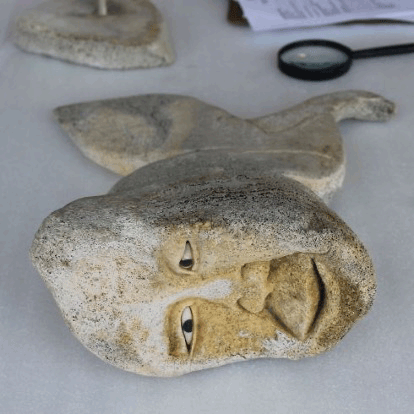
While it is important to acknowledge the multitude of prolific Inuit artists, this article will focus on the works of Inuit Nunangat artists Manasie Akpaliapik, Jacoposie Oopakak (1948-2015), Abraham Anghik Ruben, Ron Apangalook, and Shuvinai Ashoona. Where the term Inuit Nunangat is concerned, Nunangat is a necessary distinction insofar as the term Inuit reflects a population spanning the entire circumpolar area. The Inuit people reside mainly around four regions of the Arctic: Chukotka, Siberia, Greenland, and the Alaska/Canada region. This region as a whole is Inuit Nunaat, while Inuit Nunangat refers to the Canadian Arctic; in the context of this article, Inuit is short for Inuit Nunangat.
The natural impulse to preserve the use of cultural customs demonstrates a desire to connect with the ancestral past and thereby sustaining a crucial aspect of personal identity. This practice of cultural preservation is often collectively expressed through folklore. A somewhat co-opted term, folklore encompasses much more than the widely known fairy or folk tale; it is the framework of tradition, popular belief, and customs of a community. It can be read textually through decoration, clothing, and tools, or experienced through oral tradition and behavioural rituals. The aim of propagating these customs is not only to retain a memory of the past, but in some cases to declare and illuminate the past, and tether it to the present. Michael Byers, a professor of political science at the University of British Columbia recounts in his book, Who Owns the Arctic, a story of John Amagoalik, former president of the Inuit Tapirisat of Canada, who attended a conference in which a foreign diplomat declared that “nobody lived in the Arctic.” Amagoalik soon after approached the diplomat and introduced himself: “Hi, I'm nobody”.
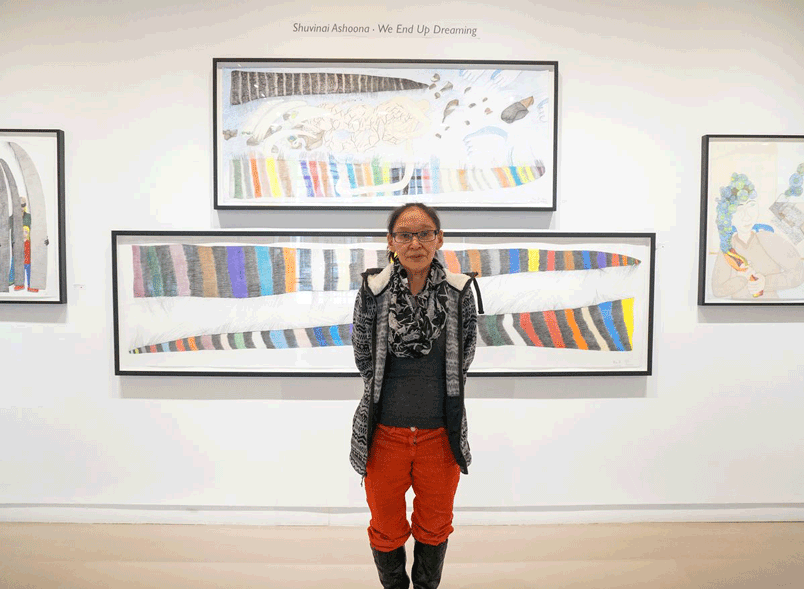
Aside from the flagrant dismissal of a peoples’ existence, another dangerous fallacy is the one that would state certain peoples’ culture must be jettisoned for the insurance of their survival. This type of thinking, although largely debunked in academia today, has been openly argued within a scholarly context, with some writers spuriously posing the question of whether or not Inuit people will choose to retain their culture, or “adapt” to the contemporary world. Why certain cultures are held to this either-or standard is another matter altogether, but in this case, artwork that incorporates tradition and history within a contemporary context stands in the face of both invisibility and the rigid compartmentalization of past, present, and future. A wonderful example can be found in Shuvinai Ashoona’s vibrant pencil and ink work, Composition (Rainbow Baleen), which was inspired by a Skittles commercial and represents the baleen of a whale – the baleen is the strong but flexible keratin filter in the jaws of certain whale species fundamental to the economy of many Inuit communities.

Among other artists exemplifying parity of past and present is Toronto-based sculptor, Manasie Akpaliapik, who states that, “Everything that I'm doing is trying to capture some of the culture, about my traditions, simple things like hunting, wearing traditional clothing, harpoons, using legends. I feel that the only way we can preserve the culture is if people can see it.” Born in a hunting camp on Baffin Island, raised by his grandparents, and sent to residential school at the age of twelve, Akpaliapik uses the carving skills he learned as a child to narrate Inuit folklore, and of the common themes in Inuit art and folklore. None of these themes are quite so foregrounded as that of the interplay between humans and animals; Akpaliapik frequently uses whalebone as the medium for his chimerical sculptures of humans, animals, and spirits.
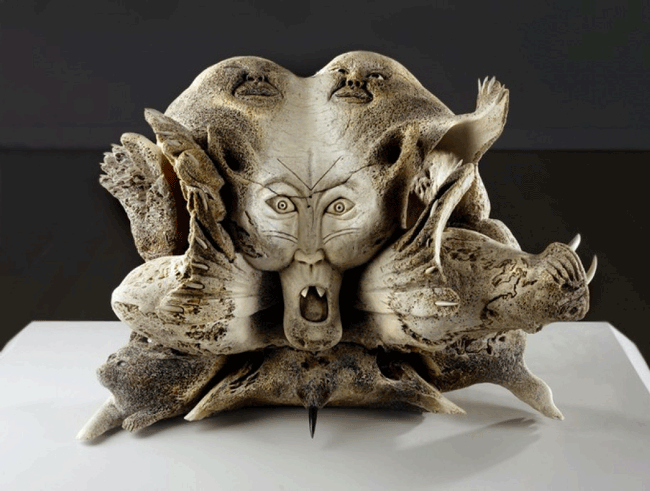
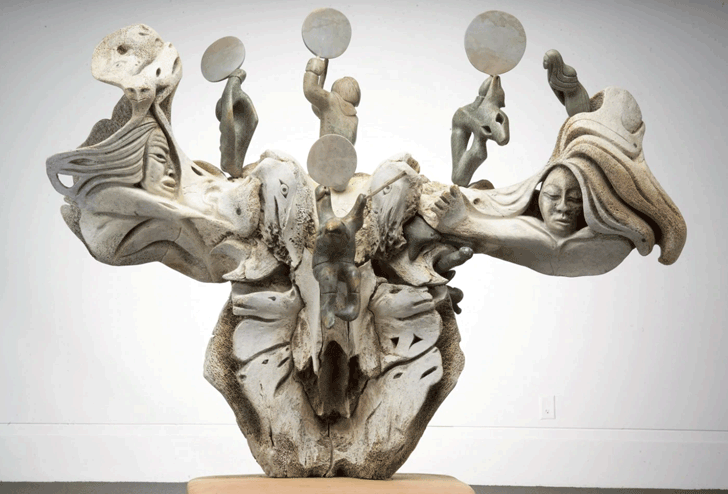
Another such artist is Jacoposie Oopakak (1948-2015), who utilized antlers and bone as a base from which to carve intricately detailed faces and animals in narrative dialogue. His piece, untitled (faces and walrus) is carved into a walrus jawbone and depicts several stratified faces leading up to the crowning head of a walrus. This motif of blending humans and animals in a transformational state is cross-culturally frequent, and in the case of Inuit culture, the concept of sustainability in human and animal interaction reflects a long-standing and crucial philosophy. Daniel Merker, a professor of psychology and religious studies notes the symmetry of animal and human spirituality: “[practices] surrounding the dressing, division, cooking, eating, sewing, and disposal of animals’ corpses are analogous, as a rule, to the rites surrounding human burial. They are designed to encourage the departure of the animals' ghosts to the afterlife realms.” In keeping with these treatments, Piita (formally Peter) Irniq, Commissioner of Nunavut from 2000-2005, remembers from childhood his mother preparing skin seals at the entrance of their igloo. He recalls that before she began, she would place a piece of freshwater ice into the dead seals’ mouths so that all seals under ice would not go thirsty. Hunting, trapping, and fishing of Arctic animals have been a means of sustaining life for Inuit people now and throughout history and is reflected in their folklore.
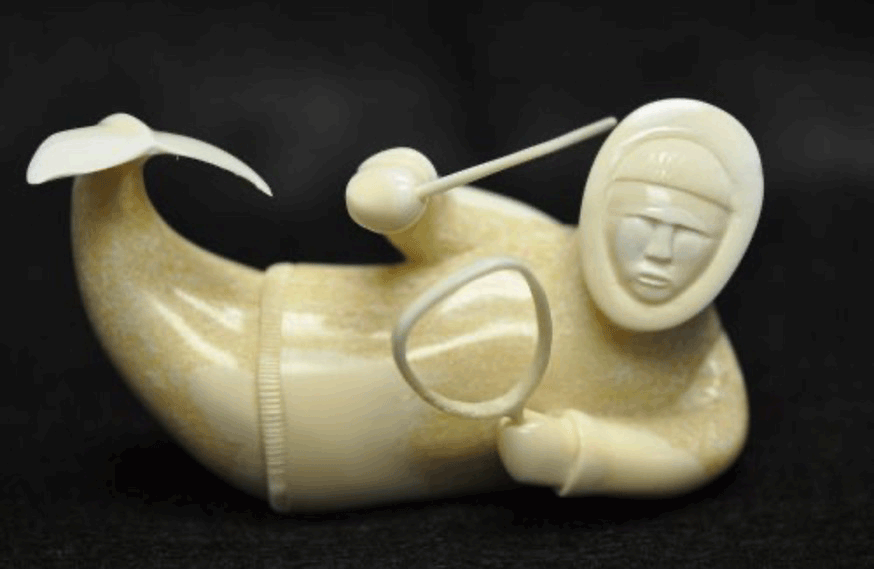
Seals are at the core of sustaining life in the Arctic; hunters give thanks and the community acknowledges their powerful connection to the animal through practice and through art. Considering the importance of seals to everyday life, it is not surprising that many contemporary artists choose to interpret in their work the classic myth of Sedna, the Sea Goddess also known as Taleelayuk, Niviaqsi, Arnakapsaaluk, Takanakapsaaluk, Takanaluk arnaluk, Nirrivik, Uinigumisuitung, and Anavgak. As one iteration of the story goes, a young woman fell in love with a handsome stranger and went to live with him on an island. Upon her arrival, she discovers that the man she thought she loved was a trickster, and in fact, a sea bird in disguise who brought her not to the beautiful land she was promised, but to a squalid nest. The young woman’s father, upon hearing of this, sets out in a boat to rescue her, but on their way back home the sea bird pursues, causing violent storms and raging the seas all around their boat. Though her father was at the first brave, he fears now mostly for his own life and tosses his daughter overboard in order to appease the sea bird. When she clings to the boat, her father cuts off her fingers, which become the ringed seals, walruses, and whales. It is then that Sedna sinks to the bottom of the sea and transforms into the Sea Goddess and provider of sea life. She is said to bear the upper body of a woman and depending on interpretation, the lower half of a fish, whale, seal, or walrus.
Among the sub-stories of that narrative is that of a preoccupied Sedna, lounging at the bottom of the ocean with a comb in hand, tending to her hair. If a Shaman wishes to win her favour and help to provide fish and seals to the community, he must first swim through the ocean to find her, where he may please her by combing and braiding her hair. Inuit-Alaskan, Ron Apangalook depicts this scene carved in walrus ivory: Sedna, with the body of a whale, reclines on one elbow, luxuriating over her hair with a small hand-held mirror. Inuvialuit artist Abraham Anghik Ruben also depicts the more sublime and volatile Sedna in his multi-faceted whalebone, soapstone, and cedar sculpture, Memories: An Ancient Past, in which he depicts Sedna’s flowing hair and figures holding mirrors.
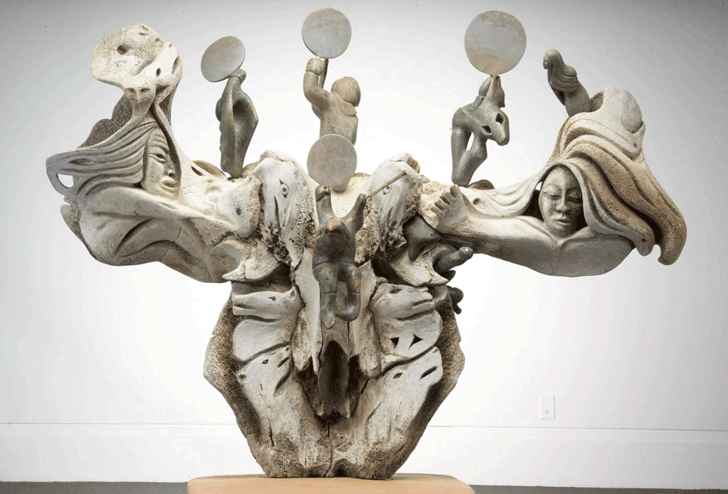
A different version of the story features a hostile side of the goddess. Though Sedna provides well for the Arctic people, if they do not pay thanks properly, she can become angered and withhold bounty, calling seals away from their air holes, summoning fish away from nets, or even causing storms and disastrous weather. It is then that they must pay respects with festivals, ceremonies, prayers and offerings; often again calling in a Shaman to invoke her spirit. Akpaliapik represents the folkloric aspects of this human and animal interplay in his whalebone piece, Shaman Summoning Taleelayuk to Release Animals. The natural grain of the whalebone adds motion through the arms, and the wood-like texture contrasts the smooth ivory faces and the ghostly impression of marine life that flows from the Shamans fingers. By carving Sedna’s face into the Shaman’s body, Akpaliapik allows us to experience the deep connection and cyclical relationship of the Inuit community with the land and animals. The medium is in perfect synchronicity with the subject; bones are universal symbols of mortality and their use connotes a sense of death but also the preservation of life. Humans are part of, not in control of, their environment.
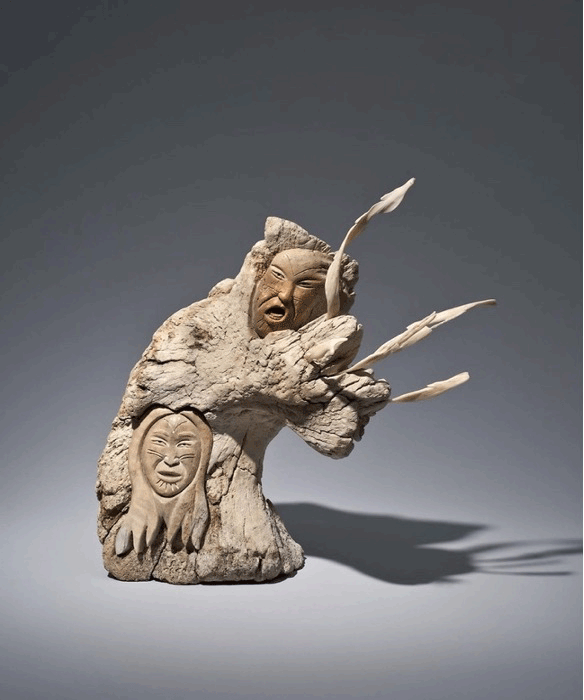
Art-making is the practice of immortalizing and expressing ideas by manifesting them into representations or tangible objects. When we do so with our stories, our customs, and our folklore, we contribute to the survival of memories and heritage. By depicting time-honoured content central to community history, and simultaneously reimagining the signifiers of that content, the aforementioned artists have contributed to the ongoing integration of the past with the present. They are sparking dialogue, addressing the past, and reinventing traditional visual language through their art.
